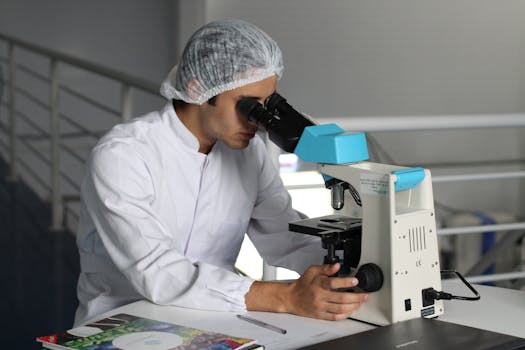Innovations in Nanotechnology
Nanotechnology, the manipulation of matter on an atomic or molecular scale, has become a transformative force across various industries. From medicine to electronics, this cutting-edge field is unlocking new possibilities and reshaping our understanding of materials and their applications. As researchers continue to push the boundaries of what is possible with nanotechnology, innovations are emerging that promise to revolutionize the way we live and work.

Medical Applications of Nanotechnology
One of the most exciting areas of nanotechnology is its application in medicine. Nanoparticles can be engineered to deliver drugs directly to diseased cells, minimizing side effects and improving treatment efficacy. For instance, researchers at MIT have developed nanoparticles that can target cancer cells specifically, leaving healthy cells unharmed (MIT.edu). This targeted approach not only enhances the effectiveness of treatments but also reduces the adverse effects commonly associated with chemotherapy.
Moreover, nanotechnology is paving the way for advanced diagnostic tools. Nanosensors are capable of detecting biomarkers at incredibly low concentrations, allowing for early diagnosis of diseases such as Alzheimer's and Parkinson's. Early detection can significantly improve patient outcomes by enabling timely intervention.
Another promising development is in regenerative medicine. Nanomaterials are being used to create scaffolds that support tissue growth and repair. These scaffolds can mimic the extracellular matrix, providing a conducive environment for cells to regenerate damaged tissues.
Electronics and Computing
In the realm of electronics, nanotechnology is driving advancements in miniaturization and performance enhancement. Silicon transistors, the building blocks of modern electronic devices, are approaching their physical limits. Nanotechnology offers alternative materials and methods to continue the trend of increasing computational power.
Graphene, a single layer of carbon atoms arranged in a hexagonal lattice, is one such material. It exhibits remarkable electrical conductivity and mechanical strength. Researchers are exploring its potential in creating faster and more efficient processors (IBM.com). Additionally, quantum dots—nanoparticles that possess unique optical and electronic properties—are being used to develop new types of displays with superior color accuracy and energy efficiency.
Another innovation is in data storage. Nanotechnology enables the creation of high-density storage devices that can hold vast amounts of data in a compact form factor. This is crucial as the demand for data storage continues to grow exponentially.
Environmental Impact
Nanotechnology also holds promise for addressing environmental challenges. One area of focus is water purification. Nanomaterials such as carbon nanotubes and metal-organic frameworks (MOFs) have shown great potential in filtering contaminants from water (Nature.com). These materials can remove pollutants at a molecular level, providing access to clean drinking water in regions where traditional methods are ineffective or too costly.
Air pollution is another critical issue where nanotechnology can make a difference. Nanoscale catalysts are being developed to break down harmful emissions from industrial processes and vehicles. These catalysts can convert pollutants into less harmful substances before they are released into the atmosphere.
Moreover, nanotechnology is contributing to sustainable energy solutions. For example, nanomaterials are being used to improve the efficiency of solar panels and batteries. By enhancing the performance and longevity of these technologies, nanotechnology is playing a vital role in the transition to renewable energy sources.
Agriculture and Food Industry
The agriculture sector is benefiting from innovations in nanotechnology as well. Nano-fertilizers and nano-pesticides are being developed to enhance crop yields while minimizing environmental impact (ScienceDirect.com). These products release nutrients or active ingredients more efficiently than conventional counterparts, reducing waste and runoff.
Nano-sensors are also being employed to monitor soil health and crop conditions in real-time. These sensors provide farmers with precise data on moisture levels, nutrient availability, and pest presence, enabling more informed decision-making.
In the food industry, nanotechnology is improving food safety and quality. Nano-coatings can extend shelf life by protecting against spoilage and contamination. Additionally, nano-encapsulation techniques are being used to enhance the delivery of nutrients in functional foods, ensuring better absorption by the body.
Safety and Ethical Considerations
Despite its many benefits, nanotechnology raises important safety and ethical concerns that need careful consideration. The long-term effects of exposure to nanoparticles on human health and the environment are not yet fully understood. Regulatory bodies are working to establish guidelines for safe production, use, and disposal of nanomaterials (EPA.gov). Ensuring thorough risk assessments and monitoring will be crucial as these technologies become more widespread.
Ethical considerations also come into play when discussing advancements in fields like medicine and agriculture. Issues related to accessibility, equity, and privacy must be addressed to ensure that the benefits of nanotechnology are distributed fairly across society.
The table below summarizes some key applications of nanotechnology across different sectors:
| Sector | Application | Benefits |
|---|---|---|
| Medicine | Targeted Drug Delivery | Improved treatment efficacy; reduced side effects |
| Electronics | Nano-processors | Enhanced computational power; miniaturization |
| Environment | Water Purification | Molecular-level filtration; access to clean water |
| Agriculture | Nano-fertilizers | Increased crop yields; reduced environmental impact |
| Food Industry | Nano-coatings | Extended shelf life; improved food safety |
The innovations in nanotechnology are ushering in a new era across multiple domains by offering unprecedented solutions to complex challenges. From enhancing medical treatments with targeted drug delivery systems to boosting agricultural productivity through nano-fertilizers, this technology holds immense promise for improving human well-being. But it is essential to balance innovation with safety and ethical considerations. Ensuring responsible development will enable us to harness the full benefits of nanotechnology while mitigating risks.